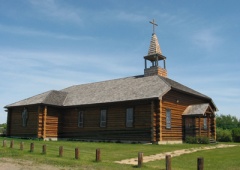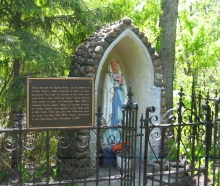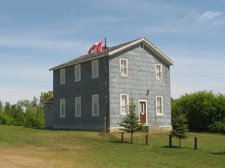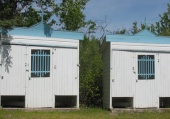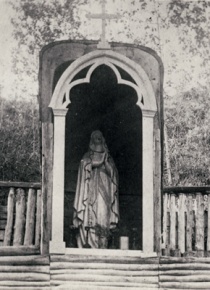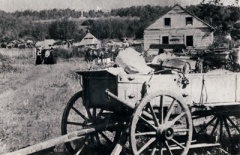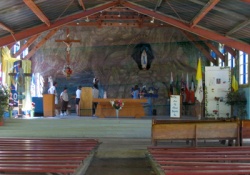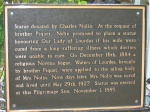Saint-Laurent Pilgrimage in Saskatchewan
par Gareau, Laurier
Saint-Laurent de Grandin is a very important religious heritage site for Saskatchewan's French-speaking community, which is also known as the Fransaskois. There once was a time when all the Fransaskois and all the French-speaking Métis of this area of Saskatchewan were devout Catholics, particularly since the Oblate clergy had played an active role as missionaries in their midst. The Saint-Laurent mission has always attracted a large number of the faithful. Located in the centre of the province on the western shore of the South Saskatchewan River, approximately ten kilometres north of Batoche, the former Métis mission receives thousands of devotees every summer for the annual pilgrimage dedicated to Our Lady of Lourdes. Today the pilgrimage is organized by the Parish of Duck Lake.
Article disponible en français : Pèlerinage de Saint-Laurent en Saskatchewan
The Pilgrimage Today
At first, the annual pilgrimage to the tiny Saint-Laurent shrine only drew members of the French speaking community and Métis from the surrounding parishes. However, soon the First Nations people from neighbouring reserves joined the procession as well. The pilgrimage has not lost its importance for the Fransaskois from the Prince Albert Diocese, even though the changes inaugerated by the Catholic Church's Second Vatican Council have altered many religious customs. The main pilgrimage takes place on July 15th and 16th and draws crowds of between 4,000 and 6,000 people a year, while some 2,000 people participate in a second pilgrimage organized later on August 15th. In fact, the very first pilgrimage took place on August 15th, 1905, to mark Assumption Day. However, the following year, Reverend Father Ovide Charlebois decided to move the annual pilgrimage up to July 16th, in order to commemorate the then most recent appearance of the Virgin Mary to Bernadette Soubirous at Lourdes in1858. Later, a second pilgrimage was organized once again, set to take place on August 15th, in honour of Mary's ascension into heaven at the end of her life.
Even though young Natives no longer participate in such large numbers, as their ancestors once did, hundreds of First Nations people still journey on foot to Saint-Laurent from the One-Arrow and Beardy reserves located only a few kilometres from the mission, just as their parents and grandparents used to do in days byegone. Another tradition that continues to this day are the two masses-one celebrated in English and the other in French-held during the July 15 and 16 pilgrimage. The mass used to be sung in Latin, while the sermon of one mass was delivered in French and the other in English.
Upon arriving on the grounds of the mission, visitors are immediately struck by the simplicity of the little log church. The original church built between 1936 and 1938 was destroyed by an arsonist in 1990. Through a collective effort undertaken by the people of the community and the diocese, the funds required for the reconstruction of the little church were raised by 1995. Volunteers from the region provided the necessary workforce. After the church, visitors will then see the old Saint-Laurent rectory and, to the left, at the top of a rise, the mission cemetery where the four Métis killed during the March 1885 Battle of Duck Lake are buried. Included among them is Isidore Dumont, the brother of Gabriel Dumont, long‑time head of the Saint-Laurent Métis community, who became the military leader of the Métis in 1885. In the history of the Northwest Métis, Saint-Laurent is almost as important as Batoche, the National Historic Site of Canada on which the 1885 Northwest Métis Rebellion is commemorated.
Immediately to the right of the rectory, a little path leads to the Saint-Laurent pilgrimage shrine, surrounded by tiny white confessionals. During the 1950s and 1960s, signs indicating a specific language (English, French, Polish, Ukrainian, German, etc.) were posted above each of these confessionals. This was becasue, at that time, it was important for confessions to be heard in the language of the worshiper. From the shrine, a path leads down to the river before winding its way back up to the shrine. The various stations of the cross are found along this path.
The History of the Site and its Heritage Value
Why do so many make the pilgrimage to Saint-Laurent de Grandin and why has this site been a religious destination for the region's Catholics for over 125 years?
In 1871, Father Alexis André, a friar from the Oblates of Mary Immaculate (OMI), managed to convince Gabriel Dumont's Métis to abandon their winter camp at "La Peitite Ville", located about 20 kilometres to the south of Batoche and to settle permanently on French-style riverfront plots. With this very idea in mind, Father André had already reserved a piece of land for a mission on the western shore of the South Saskatchewan River. It was located only a few kilometres to the north of the ferry crossing named after Xavier Letendre, also known as Batoche. Thereafter, Saint-Laurent de Grandin would become the spiritual and educational centre for the region's Métis. Then, Father André attempted to persuade a congregation of nuns to come and establish themselves at Saint-Laurent. In 1881, a Miss Onésime Dorval agreed to come to teach in the little Métis school. Then, in 1883, eight sisters from the Order of the Faithful Companions of Jesus arrived to open a convent in Saint-Laurent.
Arriving in Saint-Laurent in 1879, it was Brother Jean-Pierre Piquet who started the devotion to Our Lady of Lourdes. Born close to Lourdes, France, he had met Saint Bernadette Soubirous there. When he discovered the little stream that provided water for the mission, he was struck by how much the place resembled the miraculous site of Lourdes: "When, for the first time, he suddenly found himself across from the tiny spring from which the mission's water supply was drawn, he was greatly impressed by the surrounding landscape. For him everything recalled Lourdes: the steep hill, the trickle of water emerging from the earth, the miniscule marsh stream and even the subdued murmur of the Saskatchewan River's waters."(NOTE 1)
During the years that followed, Brother Piquet and Father Vital Fourmond (who had replaced Father André in 1873) often came to the stream to pray. Father Fourmond even set up an icon of Our Lady of Lourdes in a tree. A little before the 1885 Rebellion, an influential Métis from the area, Charles Nolin, sought out Father Fourmond and Brother Piquet in Saint-Laurent and explained to them that, for ten years, his wife had been suffering from a mysterious stomach ailment and was spitting blood. She was also suffering from chest pains, insomnia, loss of appetite and blurred vision. On the suggestions of the priests, Nolin left the mission convinced that water from Lourdes would cure his wife if she made a novena to Our Lady of Lourdes. The Métis man promised to pay for a statue for the Saint-Laurent shrine if his wife was cured. Since Rosalie Nolin did indeed experience a miraculous recovery, her husband kept his promise and donated a statue of Our Lady of Lourdes. It now replaces the icon put in the tree by Father Fourmond and still greets visitors to Saint-Laurent to this day.
After the departure of Brother Piquet and the death of Father Fourmond in 1892, the Saint-Laurent de Grandin mission fell into ruin. Before long there was not a single resident missionary left. Nevertheless, following another miraculous recovery, Brother Célestin Guillet rekindled interest in the Saint-Laurent shrine: "On September 21st, 1893, Brother Célestin Guillet, disabled by a leg injury, made a novena and a pilgrimage to the shrine. He was cured and could return to work at the Reindeer Lake mission."(NOTE 2) A few years later, Brother Guillet returned to the Saint-Laurent region to construct the Immaculate Conception Church at l'Anse aux Tourond (Fish Creek) on the right bank of the South Saskatchewan River, just opposite the former "Petite Ville" encampment site. From time to time, Brother Guillet also journeyed to the abandoned Saint-Laurent de Grandin mission. He repaired the shrine and invited the people of the region to return there as pilgrims. "The first inter-parish pilgrimage to Saint-Laurent was organized by Brother Guillet. It took place on August 15th, 1905 and in spite of the bad weather, some 500 people made their way to the shrine. They came from Bellevue, Vermillon Lake, Fish Creek, Carlton, Duck Lake and various other parishes."(NOTE 3) From that time on, the main pilgrimage has taken place on July 15th and 16th of each year, with a smaller second one set for August 15.
Saint-Laurent is not Saskatchewan's only pilgrimage site, nor is it the only one important to the Fransaskois. Nevertheless, it continues to be a powerful cultural and religious symbol for the Fransaskois community, given the ties it created long ago with the Métis and First Nations communities that continue to have significance today.
Contemporary pilgrimages to Saint-Laurent are organized by the faithful from Duck Lake's Saint-Sacrament Parish. Like most other parishes of the province, it brings together Fransaskois, Métis, Aboriginals and people of many other ethnic origins. During the 1970s, Father Gilles Doucet, who at that thime was Saint-Sacrament's parish priest, rekindled the people of Duck Lake's interest in the site and in the pilgrimage. This devotion and reverence for the site continues to this day, in spite of Father Doucet's passing. Now Duck Lake's parishioners maintain the site and organize religious activities at the shrine.
Laurier Gareau
NOTES
Note 1. Le Chevallier, R. P. Jules, OMI, Saint-Laurent de Grandin, Vanne, Imp. LaFolye and J. de Lamarzelle, 1930, p. 52. [Original citation translated into English for this text]
Note 2. Lavigne, Solange, Kaleidoscope - Many Cultures - One Faith, The Roman Catholic Diocese of Prince Albert, 1891-1991, Prince Albert (Sask.), The Diocese of Prince Albert, 1990. p. 191.
Note 3. Ibid., p. 191.
Additional DocumentsSome documents require an additional plugin to be consulted
Images
-
 Allée menant au lieu
Allée menant au lieu
du pèlerinage à... -
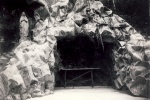 Construction d’un nou
Construction d’un nou
veau lieu de pè... -
 Fosses des Métis tués
Fosses des Métis tués
lors de la Bat... -
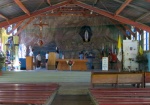 Intérieur du lieu du
Intérieur du lieu du
pèlerinage à Sa...
-
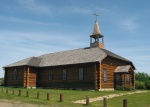 L’église en rondins r
L’église en rondins r
econstruite apr... -
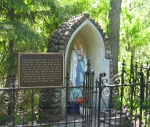 La grotte à la vierge
La grotte à la vierge
Marie avec pan... -
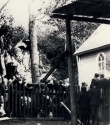 La grotte à Saint-Lau
La grotte à Saint-Lau
rent en 1917. -
 La mission de Saint-L
La mission de Saint-L
aurent de Grand...
-
 Le chemin de la croix
Le chemin de la croix
à Saint-Lauren... -
 Le vieux couvent de S
Le vieux couvent de S
aint-Laurent en... -
 Les voitures des pèle
Les voitures des pèle
rins à Saint-La... -
 Lieu du pèlerinage à
Lieu du pèlerinage à
Saint-Laurent o...

